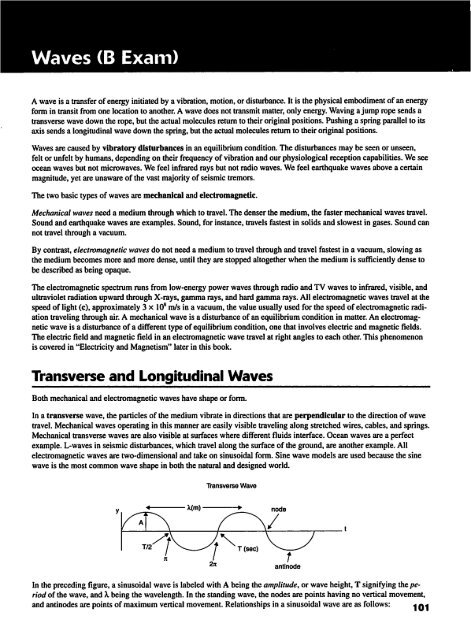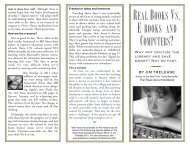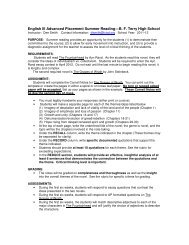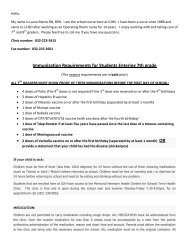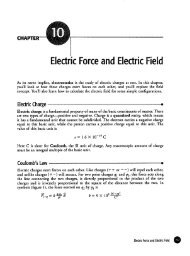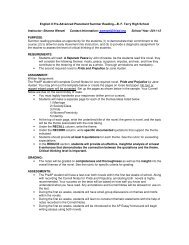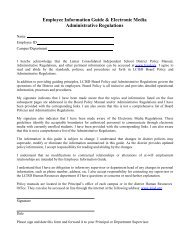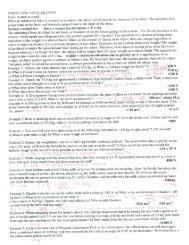Waves (B Exam)
Waves (B Exam)
Waves (B Exam)
You also want an ePaper? Increase the reach of your titles
YUMPU automatically turns print PDFs into web optimized ePapers that Google loves.
<strong>Waves</strong> (B<strong>Exam</strong>)A wave is a transfer of energy initiated by a vibration, motion, or disturbance. It is the physical embodiment of an energyform in transit from one location to another. A wave does not transmit matter, only energy. Waving a jump rope sends atransverse wave down the rope, but the actual molecules return to their original positions. Pushing a spring parallel to itsaxis sends a longitudinal wave down the spring, but the actual molecules return to their original positions.<strong>Waves</strong> are caused by vibratory disturbances in an equilibrium condition. The disturbances may be seen or unseen,felt or unfelt by humans, depending on their frequency of vibration and our physiological reception capabilities. We seeocean waves but not microwaves. We feel infrared rays but not radio waves. We feel earthquake waves above a certainmagnitude, yet are unaware of the vast majority of seismic tremors.The two basic types of waves are mechanical and electromagnetic.Mechanical waves need a medium through which to travel. The denser the medium, the faster mechanical waves travel.Sound and earthquake waves are examples. Sound, for instance, travels fastest in solids and slowest in gases. Sound cannot travel through a vacuum.By contrast, electromagnetic waves do not need a medium to travel through and travel fastest in a vacuum, slowing asthe medium becomes more and more dense, until they are stopped altogether when the medium is sufficiently dense tobe described as being opaque.The electromagnetic spectrum runs from low-energy power waves through radio and TV waves to infrared, visible, andultraviolet radiation upward through X-rays, gamma rays, and hard gamma rays. All electromagnetic waves travel at thespeed of light (c), approximately 3 x 10s m/s in a vacuum, the value usually used for the speed of electromagnetic radiation traveling through air. A mechanical wave is a disturbance of an equilibrium condition in matter. An electromagnetic wave is a disturbance of a different type of equilibrium condition, one that involves electric and magnetic fields.The electric field and magnetic field in an electromagnetic wave travel at right angles to each other. This phenomenonis covered in "Electricity and Magnetism" later in this book.Transverse and Longitudinal <strong>Waves</strong>Both mechanical and electromagnetic waves have shape or form.In a transverse wave, the particles of the medium vibrate in directions that are perpendicular to the direction of wavetravel. Mechanical waves operating in this manner are easily visible traveling along stretched wires, cables, and springs.Mechanical transverse waves are also visible at surfaces where different fluids interface. Ocean waves are a perfectexample. L-waves in seismic disturbances, which travel along the surface of the ground, are another example. Allelectromagnetic waves are two-dimensional and take on sinusoidal form. Sine wave models are used because the sinewave is the most common wave shape in both the natural and designed world.Transverse WaveMm)nodeantinodeIn the preceding figure, a sinusoidal wave is labeled with A being the amplitude, or wave height, T signifying the period of ihe wave, and X being the wavelength. In the standing wave, the nodes are points having no vertical movement,and antinodes are points of maximum vertical movement. Relationships in a sinusoidal wave are as follows:
Part II: Subject Area Reviews with Sample Questions and Answersy(x,t)=A sin 2nft = A sin (cot + kx)K = p v = y where in y is a function of x and t, A is amplitude, co is the angular velocity ( tjt L k is the angular wavenumber I -£■ rad/m) and f is the frequency.■Mm)Longitudinal WavecompressionIn the preceding figure, the wavelength of the longitudinal or compressional wave is labeled X, and areas of compression and rarefaction are labeled. A compression area is equivalent to a wave front. In a longitudinal wave, the directionof the vibration of the particles of the medium is parallel to the direction of wave travel.Some important wave relationships involve frequency (f), period (T), wavelength (X), and wave velocity (v).For electromagnetic waves traveling through either vacuum or air, the velocity is considered to be c, the "speed oflight," 3 xlO8 m/s.For sound waves traveling through air, the velocity is directly related to the air temperature. The velocity of sound at0cC is 331.5 m/s and increases by 0.6 m/s for each degree Celsius warmer. The speed of sound decreases by 0.6 m/s foreach degree Celsius cooler. This is due to the increased motion of air molecules at higher temperatures. The increase inmolecular collisions associated with this phenomenon allows faster transfer of sound through the molecules.There comes a point where the transfer of sound energy from molecule to molecule is too weak to continue due to the factthat the sound energy has spread out in a bubble, and the energy cannot reach the next air molecule. As the sound disturbance grows in distance from the source, the bubble of energy covers a larger and larger area and diminishes in strengthby the inverse-square law, I or — (This is true of all force and energy fields that emanate from a point source... sound,electromagnetic radiation, elec'tric fields, magnetic fields, and gravitational fields, although only sound waves reach a pointwhere they cannot transfer their energy through the medium, because they are the only type of energy requiring a mediumfor transmission.) All sound waves eventually turn into radiant energy, heating the molecules of their medium as they passthrough.SourceWeaker/thinner atlarger radiusStronger/denser atsmaller radiusIn any wave, the frequency is the reciprocal of the period:f=l/TIn any wave, the frequency is also equal to the velocity divided by the wavelength:102f — —
Part II: Subject Area Reviews with Sample Questions and AnswersIf the wave pulses meet perfectly in phase, and crests and troughs of both waves align perfectly (see the preceding illustration), a standing wave results. This resultant wave has twice the amplitude of either original wave and the same frequencyas both original waves.Referring to the basic transverse wave equationy(x,t) = A sin (cot + kx),a standing wave can be mathematically described asy(x,t) = A [sin (cat - kx ) - sin (tot + kx )].In sound waves, sustaining and energizing the standing wave by inputting waves at the same frequency of the standingwave produces the phenomenon called resonance and amplifies sound waves. It is the phenomenon that shatters wineglasses whose natural frequency is matched by incoming sound waves of the same frequency, causing the walls of theglass to sustain a standing wave. When the amplitude of the wave exceeds the elastic limits of the glass, it shatters.Resonance is caused by vibrating lips in brass instruments, by vibrating reeds and air columns in woodwinds, byvibrating strings in string instruments, and by vibrating surfaces and solid bars in percussion instruments.Doppler EffectThe relative motion of the source and observer can distort the perceived frequency and pitch of a sound.Christian Johann Doppler noted that sound waves approach a stationary listener at an apparently higher frequency andrecede at an apparently lower frequency than that emitted at the source. This phenomenon occurs because the soundwaves emitted by a moving source are compressed as the object moves into its own sound waves and are rarefied asthe object moves away from its own sound waves. The resulting wave compression as a sound source approachescauses the sound waves to be closer together, thus raising the apparent frequency of the compressed sound waves.When the sound source passes and moves away from the listener, the resulting wave decompression causes the soundwaves to be farther apart, thus lowering the apparent frequency of the rarefacted sound waves._ . , (f source) (Vsound)For a moving source: f0BS = fr- j^- -r( "sound i "source)(Positive for approaching and negative for receding)_ , - (f source) (Vsound± Vsource)For a moving observer: f0Bs = Htt \( "sound)(Positive for approaching and negative for receding)Red ShiftThe Doppler Effect for light is most commonly observed as the red shift for sources moving rapidly away from theobserver. It was noted by Sir Edwin Hubble that spectra of stars he observed all seemed to be shifted into the lowerfrequency red end of the visible light spectrum. Applying the Doppler Effect phenomenon for sound waves to light ledto the concept that the observed stars' apparent light frequency shift may be a result of the stars receding from our view.This extension of die Doppler Effect led to the postulation that the universe may be expanding.<strong>Exam</strong>pleLight of frequencies between 3 x 1014 Hz and 3 x 1013 Hz occupies the electromagnetic spectrum from the near-infraredto near-ultraviolet, respectively. What are the corresponding wavelengths of these frequencies?104
<strong>Waves</strong> (B <strong>Exam</strong>)SolutionUsing f=j>^ = J3x 10 waves/secAuv= ffi011* = 1 x 10-7 m/wave3 x 10 waves/secvs/sec<strong>Exam</strong>pleHow long does it take a thunder clap to travel 5 km if the air temperature is 25°C?SolutionThe velocity of sound at 25°C is331.5 m/s + (0.6 m/s/°C)(25°C) = 346.5 m/svAVE = d/t and t = d/vAVE = (5000 m)/(346.5 m/s) = 14.4 sec<strong>Exam</strong>pleA transverse wave is given asy(x,t) = 0.075 sin (1.021 + 55.0 x),where A is in m, (0 is in rad/sec and K is in rad/m. Find the wave's(a)(b)(c)(d)(e)amplitude.wavelength.frequency.period.speed.SolutionUsing y(x,t) = A sin (cot + kx),(a) amplitude = 0.075 m(b) X = (2n rad/cycle)/(55.0 rad/m) = 0.11m(c) f = 1/T = (oa rad/sec)/(2n rad/cycle) = (1.02 rad/sec)/(6.28 rad/cycle) = 0.16 Hz(d) T = 1/f = 1/(0.16 cycles/sec) = 6.25 sec/cycle(e) v = co/K = (1.02 rad/sec) / (55.0 rad/m) = 0.019 m/s<strong>Exam</strong>pleA train approaches a crossing gate at a velocity of 10.2 m/s. It sounds its horn, which has a frequency of 400 Hz. Whatare the observed frequencies of the horn (a) as it approaches and (b) after it has passed by the crossing gate? (The speedof sound in air at the time is 342 m/s.)105
Part II: Subject Area Reviews with Sample Questions and AnswersSolution... c (fsource) (f sound)Using f0BS = Ty ^ \\ VsoundX Vsource;(Negative for approaching and positive for receding)... ... (400Hz)(342m/s) ,,„ .(a) Approachmg: f0BS = {342m/s_ m^ = 412 Hz...(b)InterferenceThe corpuscular theory of light staunchly held by Isaac Newton was proven to be incorrect by Thomas Young's doubleslit experiment. Newton had held that light was made of particles because it behaved as particles behave: traveling fromone location to another in straight lines, reflecting from objects in its path, and refracting or bending when passingthrough substances of differing densities.When Young passed light through two narrow, parallel slits, he observed that the light produced an interference pattern,something that particles cannot do.Wave interference patterns were well-known through studies with water waves and sound waves.First Order ImagePrincipal ImageSecond Order lmage\n = 2In diffraction pattern problems, waves of wavelength X and velocity v approach a baffle with two slits, which are separated by a distance d. The baffle is located a distance L from a screen, onto which are projected a series of bright anddark areas. The bright spot directly across from the center of the slits is called the principal image. Each successivebright spot becomes smaller and less bright The first bright spot after the principal image is the first order image(n = 1); the second bright spot is the second order image (n = 2); and so on. Each order image lies on a line designatedto make an angle © with the line perpendicular to the center of the slits as seen in the preceding illustration. The relationship between X, d,On and n is as follows:106
<strong>Waves</strong> (B <strong>Exam</strong>)<strong>Exam</strong>pleFind the wavelength and frequency of green light whose second order image makes a diffraction angle of 40.2° if thesource is a diffraction grating having 6.30 x 103 lines per cm.Solution1 cm containing 6.30 x 103 lines yields:le,6.30 x 10J lines (100cm)Hcinft7^^= 1.59 x 10-6 m/line= d(l.59xl0-6)(sin40.2*)Using X = ^^ yields X = i ^ '- =5.13 x 10"' mFor the frequency, f = vA. = (3 x 108 m/s)/(5.13 x 10"7 m/wave) = 5.84 x 10M HzDispersionWhen white light is passed through a prism, its beam separates or disperses into the colors of the spectrum. The visiblelight spectrum spans only a narrow part of the entire electromagnetic spectrum, from about 3.9 x 10~7m in the range ofviolet/ultraviolet to about 7.2 x 10"7m in the range of red/infrared. (One wonders how the world would look to a human ifour eyes could see even 20 percent more of the electromagnetic spectrum, let alone the entire range!) The separation offrequencies of visible light into what we perceive as distinct colors is blurred by a continuous spectral gradient of gradually changing hues. The phenomenon of dispersion is ever-present in our lives, from the multicolored patterns of oil onwater to the shimmer of a rainbow to a planar circular musical diffraction grating (compact disc) with our favorite music.The diffraction patterns discussed in this chapter are mainly concerned with light and dark order images produced by aline spectrum, but the concept of dispersion includes all references to visible light of any certain wavelength, frequency,and our perception of its color.Review Questions and AnswersB <strong>Exam</strong> Question TypesMultiple Choice1 A congressional disturbance has a frequency of 100 Hz. If the speed of the disturbance is 340 m/s, the distancefrom a compression to the nearest rarefaction is(A) 0.7 m(B) 1.0 m(C) 1.7 m(D) 3.4 m(E) 4.7 m2. The difference between two audible frequencies is 4 Hz. If one frequency is 380 Hz and the speed of sound is340 m/s, the other frequency might be about(A)(B)(C)(D)(E)300 Hz325 Hz350 Hz375 Hz400 Hz
Part II: Subject Area Reviews with Sample Questions and Answers3. Spreading of wave disturbances past the edges of barriers refers to(A)(B)(C)(D)(E)AmplitudeDampingDiffractionDispersionRefraction4. An automobile hom has a frequency of 440 Hz and is traveling at 25 m/s. On a day when the speed of sound is346 m/s, the apparent frequency of the hom as heard by a person on the sidewalk as the auto approaches is mostnearly(A)(B)(C)(D)(E)110 Hz220 Hz440 Hz460 Hz880 Hz5. Wave A and wave B move toward each other on a string. Which of the following is impossible?(A)(B)(C)(D)(E)Constructive interferenceDestructive interferenceReflectionSuperpositionChange of amplitude6. X-rays having a wavelength of 6 x 10"10 m have a frequency most nearly(A)(B)(C)(D)(E)5.5xlO-|OHz5.0xl02 m/s25.0xl0"m5.0 x 10" Hz5.5x10" Hz108
<strong>Waves</strong> (B <strong>Exam</strong>)(Two-slitsource)7. A two-slit light source of wavelength X is located a distance L from a screen. The distance from the principalimage to the first order image is given as y. The slit separation d is(A)(B)(C)(D)(E)XnXn/yXnsin6asin8n/XnXn/sin6a8. A wave moving along a spring(A) cannot be transverse.(B) transports particles of matter.(C) has no kinetic energy.(D) has a definite wavelength.(E) cannot be reflected.80 m9. A ball falls a distance of 80 m on a day when the speed of sound is 340 m/s. The person who drops the ball willhear the ball hit bottom after approximately(A)(B)(C)(D)(E)1.25 sec2.00 sec2.25 sec4.00 sec4.25 sec10. A submarine's sonar system generates pulses of 2.0 x 10* Hz. If the speed of sound in water is 1450 m/s andechoes from the bottom take 0.4 sec from transmission to reception, the distance from the sub to the bottom isclosest to(A)(B)(C)(D)(E)100 m200 m300 m400 m500 m109
Part II: Subject Area Reviews with Sample Questions and AnswersAnswers to Multiple-Choice Questions1. (C) Using f = \fk, X = (v/f) = (340 m/s)/(100 Hz) = 3.4 m and the distance from crest to adjacent trough isX/2 = 1.7 m2. (D) Beat frequency of 4 Hz means that there is a difference of 4 Hz between the given frequencies. 380 Hz ± 4 Hzis either 384 Hz or 376 Hz. The closest answer is 375 Hz.3. (C) The definition of wave diffraction is the bending of waves as they pass the edges of a barrier.4. (D) Since the horn is approaching, the apparent frequency must be higher than 440 Hz. This leaves only 460 Hzand 880 Hz. At 880 Hz, the pitch of the horn would be an octave higher, which is impossible at normal automotivespeeds, thus leaving 460 Hz.5. (B) The waves will add amplitudes and interfere constructively. They will then continue on and reflect from theboundaries at each end. The only impossible answer is destructive interference.6. (D) Using f = , f = = 5.0 x 10" Hz7. (E) Usingk= dsige",d = foi/sinen8. (D) All waves have a definite wavelength.9. (E) First, the time to fall 80 m: d = vot + {Vj ) at2-80 m = 0 - 4.9 m/s2(t2) yields time to fall = 4 sec.Next, the time for the sound to travel back up: t = ot = 80 m/ 340 m/s = 4/17 sec (approximately ^ sec)Total time = 4 sec + approximately 0.2S sec = about 4.25 sec10. (C) It takes half of 0.4 sec or 0.2 sec for sound to travel from the sub to the bottom, d = (1450 m/s)(0.2 sec) =290 m (closest is 300 m).Free ResponseLightfirst order image1. Light of wavelength X equal to 4.9 x 10"7 m strikes a barrier which has two small slits separated by a distance d.A screen is placed a distance L from the barrier and is parallel to the barrier. The first order image is located at adistance y from the principal image as shown. Distance L is 0.90 m.(a) If y is 1.40 x 102 m, determine d.(b) If light of wavelength 5.1 x 10"7 m is now used, determine the new distance y for the first order image.(c) What are the frequencies of light used in (a) and (b)?110
<strong>Waves</strong> (B <strong>Exam</strong>)CrustMantleOuter CoreInner Core2. A seismic (earthquake) wave of frequency 5 Hz is recorded by a seismograph. The P-wave (primary/pressure)traveled through the Earth's mantle to the crust and was recorded first at the epicenter, directly above the focus ororigin of the earthquake. After 2.5 minutes, the S-wave (secondary/sinusoidal) was recorded. The average S-wavevelocity in the Earth's mantle is approximately 6200 m/s.(a) How deep is the focus (origin) of the earthquake?The Earth's mantle begins at an approximate depth of 30 km and ends at an approximate depth of 3000 km.The P-wave velocities at these depths are approximately 7.7 km/s to 8.2 km/s, respectively.(b)Calculate the approximate wavelengths of P-waves traveling at these two depths.3. A singer at a concert is heard by a member of the audience who is sitting 10 m away from the singer, who holdsthe microphone directly at her lips. At the same time, another listener 500 km away hears the concert broadcaston his radio earphones.(a) If the speed of sound in the auditorium is 348 m/s and the performer sings directly into the mike, who hearsthe singer first, the member of the audience or the radio listener at home? How much sooner does thatperson hear it?(b) If the concert hall air conditioner is turned on and lowers the room temperature by 5°C, who hears theconceit first and how much sooner?(c) If the radio broadcast is also carried by another station with a broadcast frequency that is higher by 10 kc/sthan that of the first station, which station's signal reaches the home listener first and by how many seconds?Ill
Part II: Subiect Area Reviews with Sample Questions and AnswersAnswers to Free-Response Questions1. (a)Using X = dsige°, d = Xn/sin0n0.090 mTo.0.014 m(b) Using X =solving for d: d =tan0n = o(4.90xl0"7)(l)= °0156and 0» = 089°(4.90xl0"7m): d =V J = oO155 =(5.1xl0"Tm), s|n0 = xn/ d = } j-4-n (3.16x10 m)tan 0.92° = y / (0.90 m) and y = 1.44 x KT2 mo.O155 = 316 X1O m= 0.0161 and 0n = 0.92°0.90 m(3xl08m/s)(c) For part (a): f = vA. = 7—^ = —r = 6.12 x 10w Hz(4.9xlO'7m/wave)(3 x 10" m/s)For part (b): f = v/X = 7—* = '—7 = 5.88 x 1014 Hz(5.1xl0"7m/wave)2. (a) Using d = vt = (6200 m/s)(150 sec) = 930,000 m or 930 km. .. (8200 m/s)A,joookm= v/1 = -t~ ;—r~ = 1640 mM00KM(5 waves/sec)3. (a) Using vAVE = d/t, t = d/v^Since the speed of sound in the auditorium is 348 m/s:'audience = 10 m/348 m/s = 0.0287 secSince radio broadcast waves travel at the speed of light, 3 xlO'm/s,= 5 x 105m/3 x 108m/s = 0.00167 secThe home listener hears it first, 0.0270 sec sooner.(b) The speed of sound in the cooled auditorium becomes:348 m/s - (0.6 m/s/0C)(5°C) = 345 m/sThis changes the travel time for the live sound to 10 m/345 m/s = 0.0299 secThe home listener still hears it first, now 0.0282 sec sooner.(c) Since radio waves all travel at the same velocity, 3x10* m/s, increasing or decreasing broadcast frequencyhas no effect on travel time.The home listener still hears it first, 0.0282 sec sooner.112


